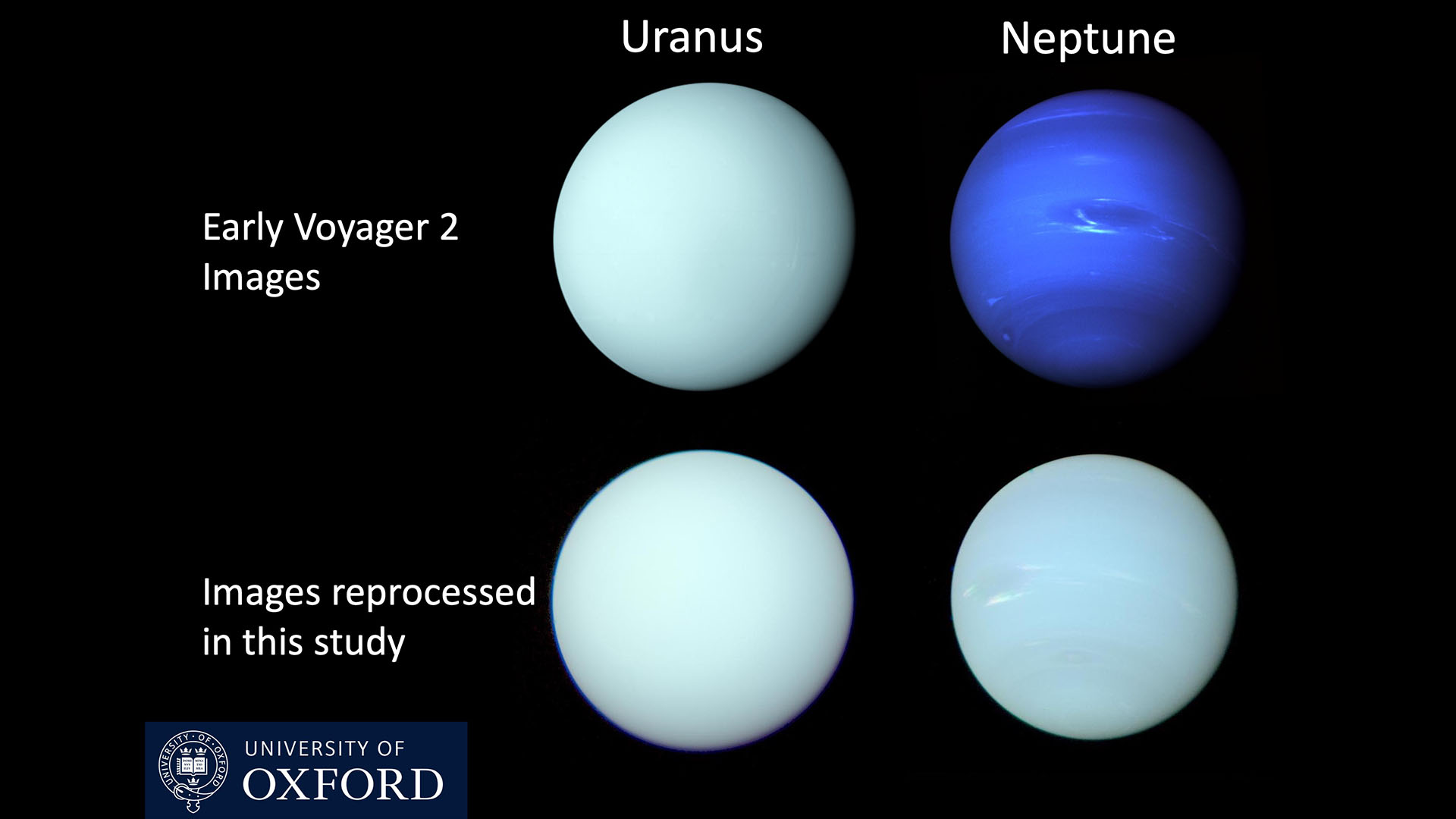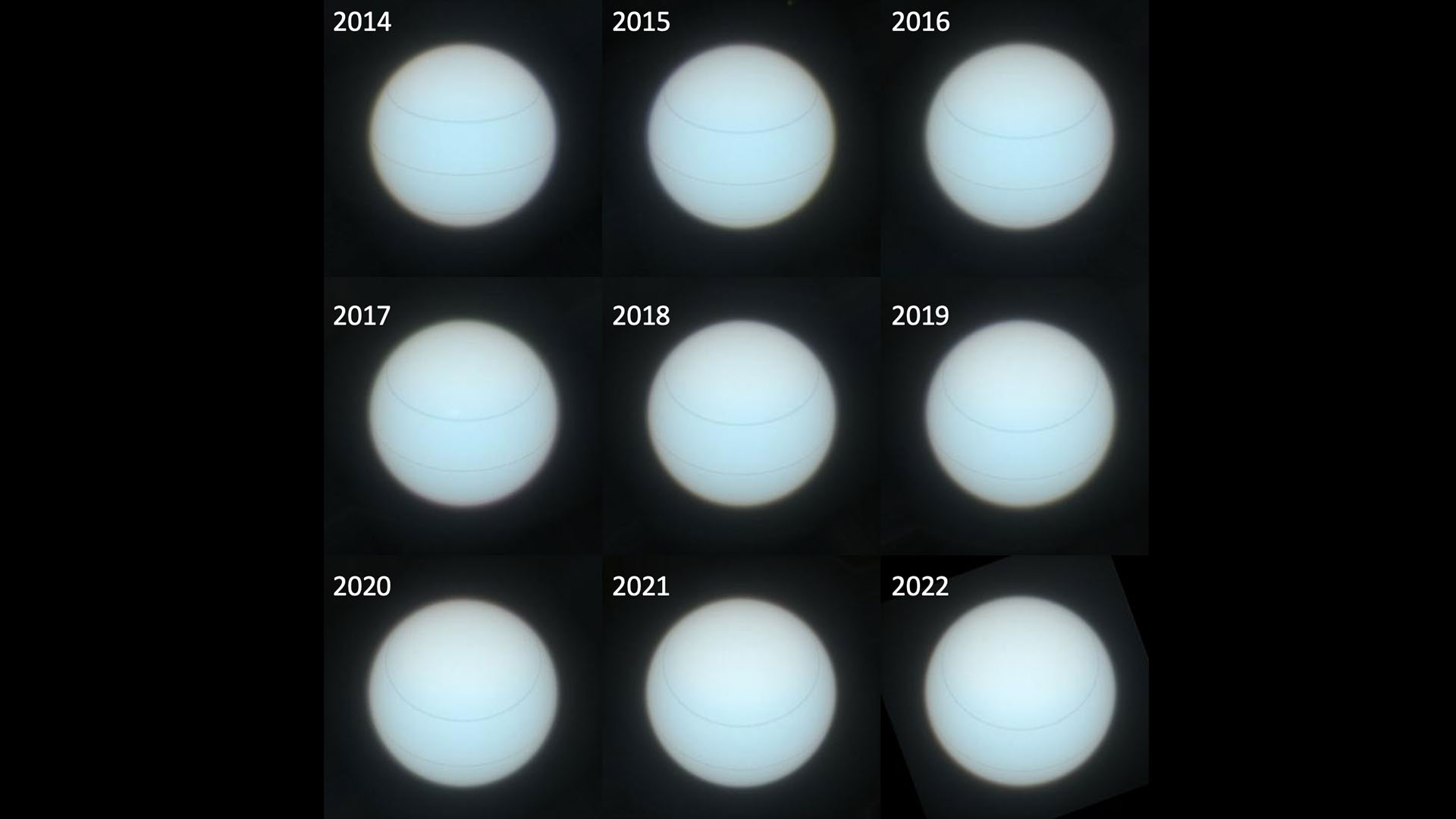Neptune isn't as blue as you think, and these new images of the planet prove it
A new treatment of images collected by Voyager 2 in the late 1980s using data from the Hubble Space Telescope has revealed the actual colors of the solar system's distant ice giants, Neptune and Uranus.

The solar system ice giants Neptune and Uranus have finally revealed their true colors — thanks to images collected by Voyager 2 three decades ago that have been polished with data from the Hubble Space Telescope and the Very Large Telescope (VLT).
Neptune was previously thought to be a dark azure, while Uranus was supposedly a lighter blueish-green. However, the polished images reveal the ice giants are much closer in color to each other and are actually a lighter blue-green hue.
The images of Uranus, the seventh planet from the sun, and Neptune, the eighth planet, were collected in 1986 and 1989, respectively, as NASA's Voyager 2 spacecraft headed out of the solar system. A team of researchers recently reprocessed the images, which were published Thursday (Jan. 4) in the Monthly Notices of the Royal Astronomical Society.
Related: Spiral galaxies like the Milky Way are surprisingly rare. Astronomers may finally know why.
"Applying our model to the original data, we have been able to reconstitute the most accurate representation yet of the color of both Neptune and Uranus," lead study author Patrick Irwin, a planetary physicist at the University of Oxford, said in a statement.
How Neptune and Uranus hid their true colors
Scientists knew the ice giants likely looked different than images suggested.That's because when missions like Voyager 2 — thus far the only spacecraft to visit the ice giants — observed Uranus and Neptune, they did so in single wavelengths of light at a time. As a result, all images of them were composites built from several single-color observations of the planets.
These composite images weren't always well-balanced enough to paint a true picture of the planets' colors. This was especially true in the case of Neptune. The contrast in many images of Neptune was enhanced to enable scientists to better see the bands that stretch across the ice giant, as well as its clouds and storms.
"Although the familiar Voyager 2 images of Uranus were published in a form closer to 'true' color, those of Neptune were, in fact, stretched and enhanced, and therefore made artificially too blue," Irwin said. "Even though the artificially saturated color was known at the time amongst planetary scientists — and the images were released with captions explaining it — that distinction had become lost over time."
Get the world’s most fascinating discoveries delivered straight to your inbox.
Neptune is "less blue" now thanks to Hubble
To obtain true-color images of Neptune and Uranus, Irwin and colleagues turned to data collected by the Hubble Space Telescope's Imaging Spectrograph (STIS) and Wide Field Camera 3 (WFC3). The team also used data gathered by the Multi Unit Spectroscopic Explorer (MUSE) on the Very Large Telescope (VLT) located in the Atacama Desert of northern Chile.
In the images taken by these instruments, each pixel is a continuous spectrum of colors, meaning the data they collected could be used to rebalance the composite images built by Voyager 2.
The results showed that both ice giants are a similar icy cool greenish blue, though Neptune is slightly bluer. The scientists think this is the result of Neptune having a thinner layer of haze surrounding it than Uranus does.
The research also explains why Uranus changes color slightly during its 84-Earth-year orbit of the sun. Previous observations showed that the ice giant appears a touch greener during its summer and winter solstices, when one of its poles is pointed towards the sun, than during its equinoxes, when the sun is above the ice giant's equator.
Irwin and colleagues think this is the result of a "hood" of icy methane increasing the reflection at green and red wavelengths at Uranus' poles. This hood is absent at the equator.
"This is the first study to match a quantitative model to imaging data to explain why the color of Uranus changes during its orbit," Irwin said. "In this way, we have demonstrated that Uranus is greener at the solstice due to the polar regions having reduced methane abundance but also an increased thickness of brightly scattering methane ice particles."
Heidi Hammel, vice president for science at the Association of Universities for Research in Astronomy (AURA), said the new images address lingering ice-giant puzzles.
"The misperception of Neptune's color, as well as the unusual color changes of Uranus, have bedeviled us for decades," Hammel said in the statement. "This comprehensive study should finally put both issues to rest."
Robert Lea is a science journalist in the U.K. who specializes in science, space, physics, astronomy, astrophysics, cosmology, quantum mechanics and technology. Rob's articles have been published in Physics World, New Scientist, Astronomy Magazine, All About Space and ZME Science. He also writes about science communication for Elsevier and the European Journal of Physics. Rob holds a bachelor of science degree in physics and astronomy from the U.K.’s Open University




